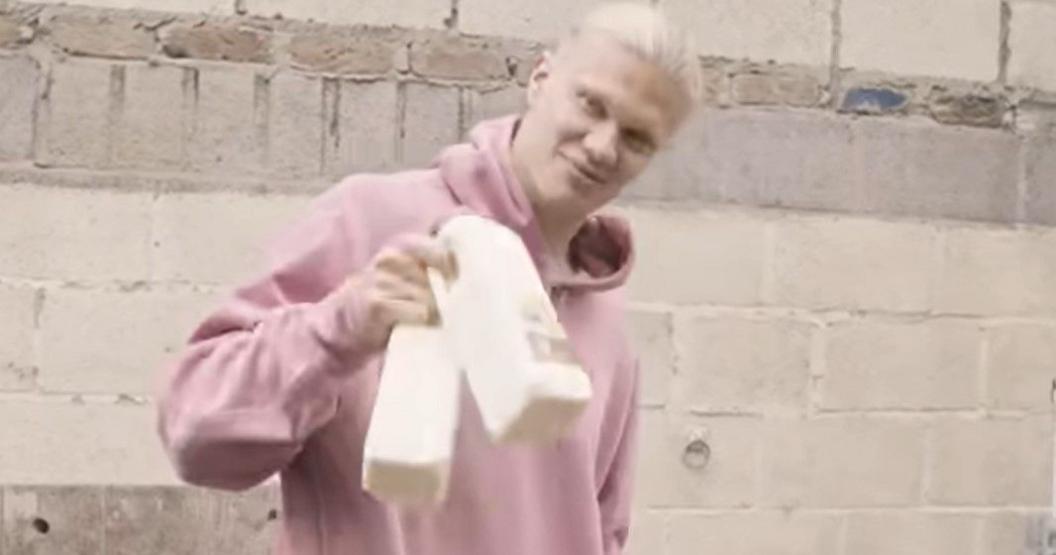How Haaland prompted a debate on drinking raw milk

Manchester City and Norway striker Erling Haaland has scored 24 goals for club and country this season
- Published
The first video posted on Erling Haaland's new YouTube channel has attracted more than five million views - and prompted discussion about his consumption of raw milk.
In an episode titled 'Day in the life of a pro footballer', Manchester City and Norway striker Haaland, 25, speaks about his daily routine and enjoyment of cooking - and eating - tomahawk steaks.
But he also talks about his taste for drinking raw, unpasteurised milk, which cannot be bought in shops or supermarkets - though its sale is legal in England.
The Food Standards Agency (FSA) advises it "may contain harmful bacteria that can cause food poisoning" and therefore should not be consumed by people with weaker immune systems, including those aged 65 and over, pregnant women, small children and those with a compromised immune system.
But why does Haaland drink it and what are the wider implications, including for those thinking of following suit?
What is raw milk and how much does Haaland drink?

Haaland was seen collecting his supply of raw milk from a farm in Cheshire
In the YouTube episode, Haaland is filmed visiting a farm in Cheshire to collect his supply of raw milk.
He refers to it as a "superfood" that he believes is "good for the stomach, good for the skin, the bones and muscles", adding: "That is why I drink it."
Sources close to the striker have told BBC Sport he drinks one glass every morning and another after training - a ritual that has been a part of his life for as long as he can remember.
Put simply, Haaland feels it makes him healthier, which is an important mindset for an athlete at the peak of their profession. Basically, it's more a life choice for him than one taken with sporting nutrition in mind.
It is understood some of Haaland's City team-mates also drank raw milk before his arrival, though it is not known how many - or how much they consume.
The majority of milk drunk in the UK is heat-treated - or pasteurised - to kill off harmful bacteria. Raw drinking milk is not produced in the same way - going straight from the animal to the bottle without any treatment.
"Raw milk may contain food poisoning bacteria, so there are extra checks and hygiene standards for raw drinking milk producers," says FSA deputy director of policy Natasha Smith.
"While these stricter controls aim to help make sure it's safer and support consumer choice, it's important to remember vulnerable people should avoid it."
Is raw milk readily available?
The sale of raw cow's drinking milk is legal in England, Wales and Northern Ireland - but it can only be sold directly to consumers by registered raw drinking milk production farms, at registered farmers' markets, and by distributors with milk-round vehicles. It is banned in Scotland.
Raw milk must come from animals that are free from diseases such as tuberculosis, from farms that comply with hygiene rules and are routinely inspected twice a year, and must be labelled with the appropriate health warning.
Sources at the FSA say they regularly review the controls on raw drinking milk and aim to support consumer choice, which they balance alongside protecting the health of the public.
What do the experts say?
Despite its listing as a "risky" product, the FSA say there has been an increase in the popularity of raw milk because "people believe it has health benefits" - though it says there is little credible scientific evidence to support that.
The farm at which Haaland was filmed buying milk wrote on Facebook that its product had been "rather in demand" since the episode was posted, staff had been "frazzled", and it hoped to "buy a new dairy cow very soon" so orders could be met more quickly.
Former City academy nutritionist Dan Richardson told BBC Sport he would always look for the "safest approach possible" so as "not to compromise on the safety of food".
He said: "The challenge with raw milk is that you can get some companies who do a good job in reducing the risk factor to bacteria, and I am sure Haaland will be using the premium quality available out there.
"A nutritionist is not going to allow him to buy raw milk that has a high risk of contamination. When people begin to copy these dietary habits, it can become unsafe as people will go out and buy the cheapest and most accessible version that may carry the food-borne illnesses."
Asked if he felt the trend of drinking raw milk would gain momentum, Richardson said: "Unfortunately, I can see it happening."
For Haaland, drinking raw milk is part of an unconventional off-field routine that also includes red-light therapy and adding maple syrup to his coffee.
Richardson added: "Young athletes need to remember that getting the right amount of carbohydrates, hitting the protein intake and eating three regular meals with snacks is a better approach than jumping towards trends.
"Some athletes will try to find a quick fix by replicating a role model rather than doing the mundane stuff really well.
"We just want to use safe food where possible."